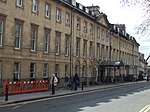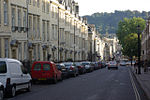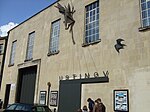Queen Square, Bath

Queen Square is a square of Georgian houses in the city of Bath, England. Queen Square is the first element in "the most important architectural sequence in Bath", which includes the Circus and the Royal Crescent. All of the buildings which make up the square are Grade I listed. The original development was undertaken by John Wood, the Elder in the early 18th century. He designed the building frontages following the rules of Palladian architecture and then sub-let to individual builders to put up the rest of the buildings. The obelisk in the centre of the square was erected by Beau Nash in 1738 in honour of Frederick, Prince of Wales. During World War II several buildings on the south side of the square were damaged by bombing during the Bath Blitz. Following restoration many of the buildings are now offices with the west side housing the Bath Royal Literary and Scientific Institution and on the south side the Francis Hotel.
Excerpt from the Wikipedia article Queen Square, Bath (License: CC BY-SA 3.0, Authors, Images).Queen Square, Bath
Queen Square, Bath Kingsmead
Geographical coordinates (GPS) Address Nearby Places Show on map
Geographical coordinates (GPS)
| Latitude | Longitude |
|---|---|
| N 51.383611111111 ° | E -2.3636111111111 ° |
Address
Queen Square Sb
Queen Square
BA1 2HB Bath, Kingsmead
England, United Kingdom
Open on Google Maps











